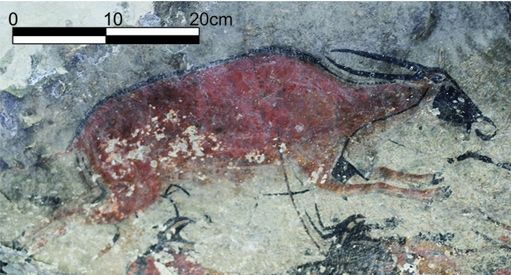New Technique Shows San Rock Art Is 5,000 Years Old
Using a highly refined form of carbon dating, researchers were able to date the pigments in art in Botswana, Lesotho and South Africa
/https://tf-cmsv2-smithsonianmag-media.s3.amazonaws.com/filer/e6/b3/e6b34075-4ad9-45fe-a662-fb322be8d9c1/rock_art_3.jpg)
Dating rock art is difficult. Chips of paint—likely contaminated with all different sources of carbon due to centuries and sometimes millennia of weathering—are first removed from the delicate pieces of art. Then researchers must use these pigments to isolate dateable carbon in order to come up with an age. Laura Geggel at LiveScience reports that one researcher just spent more than seven years overcoming some of those obstacles to date rock art from the San people of southern Africa. Her efforts paid off—her team found that some of the art is 5,000 years old, much more ancient than researchers previously thought.
According to Léa Surugue at The International Business Times, the researchers used a technique called accelerator mass spectrometry (AMS) to analyze paint chips from cave paintings in 14 sites in Botswana, Lesotho and South Africa. This newer technique allowed them to use tinier samples of the material. “With current dating methods, we need large samples—sometimes hundreds of milligrams of painting—which often means completely destroying these artworks,” explains Adelphine Bonneau, post-doctoral fellow at Laval University and first author of the article in the journal Antiquity. "We also have to consider that in many cases, the art wasn’t protected inside caves and rock shelters but created on outdoors rocks exposed to the elements and to human activity, which means that paintings are often in a bad state and cannot be dated.”
Bonneau and her colleagues selected samples made from organic materials that contained carbon, but avoided samples made from charcoal, since that material can last a very long time and paintings made with old pieces of charcoal could throw off the dates. They also worked to identify all the sources of carbon in the samples, since wind, rain, dust and all sorts of things can contaminate the paintings. Bonneau tells Geggel she’s even witnessed sheep licking the paintings.

They then examined the samples using AMS, coming up with dates for when the paintings were made. The research showed that the ancestors of the San people created their images of animals and hunters using three primary materials including charcoal, soot and carbon black, a mixture of fat. The AMS dating showed that the paintings in rock shelters in Botswana ranged from 5,000 to 2,000 years old. The Lesotho paintings were from 1,500 to 150 years old and the South African art was 2,500 to 150 years old. The dates show that the rock shelters were used over several centuries.
“For the first time, it is possible to understand how the paintings on a shelter were created,” Bonneau tells Geggel. “[It shows] when and where the artists started to paint in the shelter [and] for how long it was used. It opens up the possibility to discuss why some shelters were used for long periods and whereas other ones seem to have only one phase of paintings.”
Surugue reports that dating the paintings will allow researchers to begin associating some of the archeological artifacts found in and near the rock shelters with the people who created the cave paintings.
Even more importantly, the techniques used to date the rock art can be used in other areas of the world. For instance, rock art on the Indonesia island of Sulawesi was found to be a minimum of 40,000 years old using a technique called uranium-thorium radioisotope dating. Bonneau hopes her technique will help researchers paint a better picture of historical art by refining dating techniques even more.